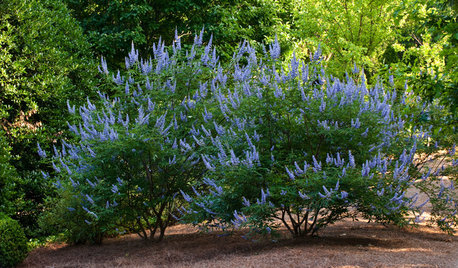stemless blue violets other than V. sororia
trisha_mo
20 years ago
Related Stories

MORE ROOMSCloser Look: Violet's Magical Nursery
Lauren Hufnagl creates a chic and soothing nursery on a budget
Full Story
HEALTHY HOMEBath Design: Renew Body and Mind With Colorful Light
Take one tired, stressed-out self. Rinse in a shower bathed in blue light (or any color you like). Repeat
Full Story
MOST POPULAR50 Shades of Gray
Gray is hotter than ever, thanks to a hit novel full of risks and dark secrets. Tell us: Which paint shade possesses you?
Full Story
COLORLet Purple Passion Infuse Your Home
We take the mystery out of using this most spiritual of colors to create a deeply beautiful interior design
Full Story
DECORATING GUIDESThe Case for In-Between Colors
These mutable hues defy easy description, but their appeal all around the home isn't hard to get
Full Story
FLOWERS AND PLANTSVitex Agnus-Castus Fills Gardens With Fragrant Blooms and Foliage
Spikes of purple flowers adorn chaste tree’s aromatic foliage throughout the warm season in Southern gardens
Full Story
GROUND COVERSNative Alternatives to English Ivy, Japanese Pachysandra and Periwinkle
These shade-loving ground covers are good for the environment and say something about where you are
Full Story
GARDENING GUIDES6 Plants That Beat Butterfly Bush for the Wildlife Draw
It's invasive, a nonnative and a poor insect magnet. Check out these better alternatives to butterfly bush in the garden
Full Story
FUN HOUZZHouzz Quiz: What Color Should Your Front Door Be?
Think you’re hip enough for orange? Or optimistic enough for yellow? Take our front-door personality quiz and find out
Full Story






Mike Hardman
trisha_moOriginal Author
Related Professionals
Camas Landscape Architects & Landscape Designers · Tempe Landscape Contractors · Berkley Landscape Contractors · Cambridge Landscape Contractors · Dallas Landscape Contractors · Essex Landscape Contractors · Florham Park Landscape Contractors · La Verne Landscape Contractors · Mastic Beach Landscape Contractors · Northport Landscape Contractors · Norwalk Landscape Contractors · Palos Verdes Estates Landscape Contractors · South Lyon Landscape Contractors · Tehachapi Landscape Contractors · Woodburn Landscape ContractorsMike Hardman